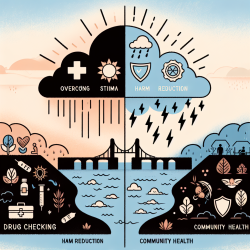Breaking Down Barriers: The Role of Stigma in Drug Checking Services
In the ongoing battle against the overdose crisis, community drug checking has emerged as a vital harm reduction strategy. However, stigma remains a formidable barrier to accessing these essential services. A recent study titled Substance Use Stigma and Community Drug Checking: A Qualitative Study Examining Barriers and Possible Responses delves into this issue, offering insights and strategies to mitigate stigma and enhance service accessibility.
Understanding Substance Use Stigma
Substance use stigma (SUS) is a pervasive issue that affects individuals at multiple levels—individual, interpersonal, and structural. The study identifies various types of stigma, including anticipated, internalized, enacted, and systemic stigma, each contributing to the reluctance of individuals to engage with drug checking services.
Individual Level: Anticipated and Internalized Stigma
Anticipated stigma refers to the fear of being judged or discriminated against, while internalized stigma involves accepting negative societal views about substance use. These forms of stigma can deter individuals from seeking drug checking services, fearing exposure and judgment.
To counter these barriers, the study suggests creating service models that ensure anonymity and privacy. Public yet discreet locations like pharmacies or community health centers can provide a stigma-free environment. Additionally, employing respectful and non-judgmental staff can foster a welcoming atmosphere.
Interpersonal Level: Enacted and Episodic Stigma
Enacted stigma involves direct discrimination or judgment from others, while episodic stigma occurs in isolated incidents over time. The study highlights the importance of hiring staff with lived experience in substance use, as they are more likely to offer empathetic and non-judgmental support.
Normalizing drug checking through public campaigns and integrating services into common spaces can also help reduce interpersonal stigma. By promoting drug checking as a routine health practice, we can shift public perception and reduce judgment.
Structural Level: Criminalization and Systemic Stigma
Structural stigma is deeply embedded in societal institutions and often manifests through criminalization. Fear of legal repercussions can deter individuals from accessing drug checking services. The study suggests that decriminalization and policy reforms are crucial in addressing these systemic barriers.
Moreover, public education campaigns that promote the benefits of drug checking can help shift societal attitudes and reduce systemic stigma. By treating substance use as a public health issue rather than a criminal one, we can foster a more supportive environment for harm reduction services.
Implementing Change: Strategies for Practitioners
Practitioners can play a pivotal role in reducing stigma by advocating for policy changes and creating inclusive service environments. Employing individuals with diverse backgrounds and experiences can enhance service delivery and build trust with service users.
Furthermore, practitioners should engage in ongoing education and training to understand the complexities of substance use stigma and its impact on service accessibility. By adopting a holistic approach, we can create a more inclusive and effective harm reduction framework.
Conclusion
Addressing substance use stigma is essential for the successful implementation of drug checking services. By understanding and mitigating the barriers posed by stigma, we can enhance service accessibility and contribute to the broader harm reduction efforts in the overdose crisis.
To read the original research paper, please follow this link: Substance Use Stigma and Community Drug Checking: A Qualitative Study Examining Barriers and Possible Responses.










